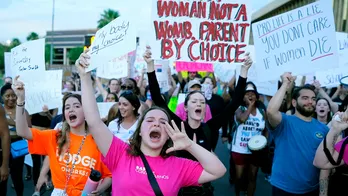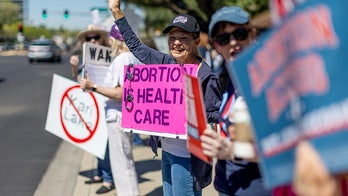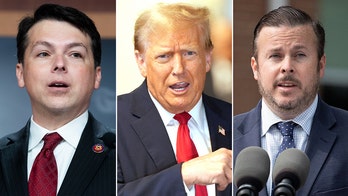Lights, camera, action!
The State of the Union speech morphs the U.S. Capitol into a Hollywood soundstage
It's the only event that unites the disparate trinity of the executive, legislative and judicial branches for an annual convocation. And the country's media then focuses on the House chamber for one of the most hallowed rituals in American politics.
You know the drill. The president speaks to a nationally-televised audience. A member of the loyal opposition usually responds, often from a quiet room somewhere in the Capitol.
It seems very pre-packaged back home.
But on Capitol Hill, it's a complicated ballet that starts days in advance.
The appearance of a gigantic jib camera and crane in the House chamber is often one of the first signs that a big speech is coming. The jib camera appeared Monday. This is the camera that provides "fly-in" shots from above the House floor. It's kind of like the camera that hovers above the field in an NFL game.
The House prohibits private media from televising regular Congressional sessions, offering its own feed. But for State of the Union, the House permits a few cameras into the chamber. The networks combine their resources into a "pool," to televise the speech. Extra cameras in the chamber allow the networks to show reaction shots from lawmakers. Directors in the truck can also call for shots of particular figures when the president mentions a specific topic in which that member takes interest.
But it would be Tuesday until more obvious signs emerged around the Capitol that the State of the Union speech was imminent.
One of the least likely locations to trace State of the Union activities is an obscure hearing room at the end of a long corridor in the Cannon House Office Building. TV networks strung spools of cable down the stairwells and behind a closed hearing room door.
Media rarely visit this territory. But this was the House Budget Committee hearing room, the domain of House Budget Committee Chairman Paul Ryan (R-WI). The GOP brass tapped the wonkish Ryan to deliver the party's official response after the president's address. And Ryan was holed-up in the room for part of the day, rehearsing his ten-minute address.
Ryan did some mild retrofitting to his hearing room for his remarks. Aides yanked out one row of desks where witnesses or clerks sit during hearings. In its place, they added a lectern. And they fashioned the room with a big, TV-friendly blue curtain to serve as a backdrop. They also positioned an American and a Wisconsin flag behind the Congressman.
While the official response is a longtime staple of State of the Union speeches, this year's exercise introduced a new phenomenon into the mix: the seventh grade mixer.
In the pursuit of bipartisanship, lawmakers from both sides of the aisle, from both the House and Senate, clamored to sit with one another during the address. Many then announced their "date" via Twitter or Facebook. Reporters struggled to keep up with which lawmaker agreed to appear on another member's dance card.
And like every school dance, there was inevitably some drama about who was going with whom.
On Tuesday morning, House Majority Leader Eric Cantor (R-VA) invited House Minority Leader Nancy Pelosi (D-CA) to sit with him at the speech. But later in the day, Pelosi tweeted a message, where she thanked Cantor for the invite, but politely declined. Pelosi had already asked Rep. Roscoe Bartlett (R-MD) to be her seatmate.
Of course, this threatened to create a scene like the number "Telephone Hour" in "Bye, Bye Birdie." That's where a pubescent Harvey Johnson, complete with a cracking voice, repeatedly dials girls and invites them to the prom. Before the end of the song, Penelope Ann, Debra Sue and Charity have all rebuffed poor Harvey's entreaties.
To make things more interesting, word came Monday that the 83-year-old Bartlett was also already committed to sit with Rep. Judy Chu (D-CA).
But being the Congressional Casanova that he is, Bartlett simultaneously cleared up the confusion and impressed his colleagues by announcing that both Chu and Pelosi were his dates for the evening and he would sit between them.
"I look forward to sitting between two lovely ladies," Bartlett said.
A gentleman to the end, Bartlett even brought both dates Dove dark chocolates.
"Dove has the highest levels of anti-oxidants of any dark chocolate," Bartlett bragged later.
But alas, Cantor didn't wind up like Harvey Johnson in the musical.
Before the afternoon was through, the leader announced that Rep. Bobby Scott (D-VA) would sit with him. The districts represented by Cantor and Scott share a common border and both work together frequently on regional issues. Both lawmakers represent parts of Richmond, VA.
By early afternoon, lawmakers engaged in the Congressional equivalent of calling "shotgun" as they staked out seats in the House chamber. Most accomplished this task by taping a business card to the backs of the seats. For instance, Reps. Doc Hastings (R-WA), Norm Dicks (D-WA) and Jerry Lewis (R-CA) claimed some chairs on the Democratic side of the aisle. Reps. Charlie Bass (R-NH) and Jay Inslee (D-WA) were also slated to sit together.
But the House usually prohibits seat saving. When the Democrats controlled the House, the presiding officer would announce that seat saving was prohibited during State of the Union. And shortly after the House recessed to prepare for the president, House employees would buzz through the chamber and toss all of the papers and cards in the trash.
On Tuesday, Rep. Shelley Moore Capito (R-WV) did her duty as presiding officer when she informed lawmakers that seat saving wasn't allowed and that the rules "would be applied strictly."
However, no one bothered to enforce the rules. And lawmakers saved nearly every seat in the chamber.
There's a key telltale sign that the State of the Union speech is drawing closer: the influx of security and media.
By late afternoon, House staffers dropped off several dozen, dark duffel bags around the chamber. Each bag was equipped with escape hoods in case someone unleashed a chemical or biological attack on the Capitol during the speech. Bomb sniffing dogs soon began walking the length of the Capitol, checking out every nook and cranny. Men in environmentally-secured spacesuits roamed the Capitol Rotunda during the speech, ready to swing into action if necessary.
Most of the action unfolded in Statuary Hall, the ornate room lined with statues that served as the House chamber in the early 19th Century.
Statuary Hall is where hundreds of reporters mass to grab reaction from lawmakers after the speech. The media who operate there sort of move in like the Mongol Horde, taking over Statuary Hall with dozens of cameras, cables and gigantic TV lights.
This is where correspondents do their stand-ups and interview lawmakers after the speech. For instance, ABC was assigned a position by the statue of Brigham Young, a key figure in the Church of Jesus Christ of Latter-day Saints. FOX and Washington, DC affiliate WTTG-TV occupied space between statues of Alexander Hamilton Stephens, the vice president of the confederacy and House Speaker Henry Clay. CBS was backed up to Robert Fulton, developer of the steamboat. Al Jazeera camped out with the statue of Texas senator Sam Houston.
Lawmakers poured into Statuary Hall after the speech to give their views. Dozens opted to release statements on paper or video before the speech was done, asking reporters to embargo their remarks. Even though they hadn't heard or read the speech.
Come midnight, most of the lawmakers trickled out of the Capitol. The media crews rolled up the miles of cable and packed up their cameras. The crush of Secret Service agents dissipated.
By 1 am, there were few signs the House chamber had been the most focused upon room in the world earlier.
The lights were now dialed low in the House chamber. And a lone custodian polished a rail near the back of the room as a tinny radio blared a tune by Shakira.




